The dataset in this article demonstrates the consequences of the important tests that were led with Argentinian crude oil saturated with methane gas. Four primary depletion tests were conducted with crude oil using depletion rates of 0.35psi/min, 0.23psi/min, 0.048psi/min, and 0.023psi/min. All tests started with the sand-pack fully saturated with live oil at irreducible water saturation. All the tests were conducted at a room temperature of 22±0.7 degree centigrade. What's more, the outcomes were dissected to surmise the impact of gas oil proportion and other foamy oil parameters on the depletion trend.
Keywords: Live oil, Methane gas, Crude oil, Argentina
- During the initial segment of the depletion, the pressure at all locations decreases linearly in tandem with the pressure at the production port Figures 1-4.
- The pressure gradient remains too small to measure and there is very little oil production during the fast depletion, and this behavior is consistent with the liquid phase expansion under decreasing pressure. As the pressure declines, the dissolved gas super-saturation continues to increase and eventually leads to nucleation of gas bubbles Figure 1, Table 1.
- The gas production data is somewhat noisy due to the disturbance created when the collection vessel had to be emptied Figure 5.
- There was no oil production for the first four days of slow depletion test while the sand-pack pressure declined to about 420psig. That is where the gas nucleation started and oil production began. There is just a hint of pressure difference between the two ends of the sand-pack immediately after bubble nucleation.
- It appeared that the increase in oil recovery with increasing depletion rate reaches an asymptotic limit and the test @0.434psi/min is already close to this performance limit and it is likely that a lower limit of performance also exists when the rate is made progressively slower.
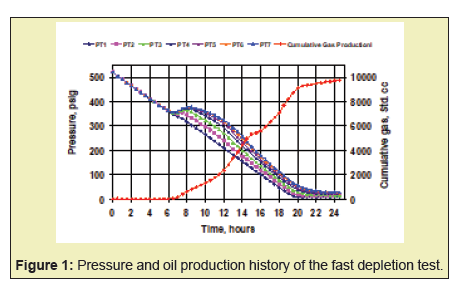
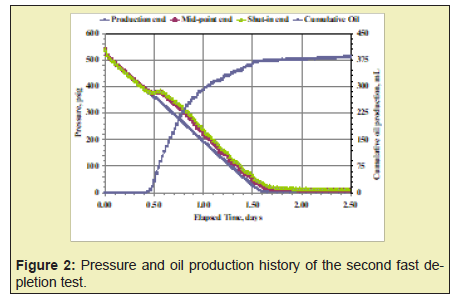
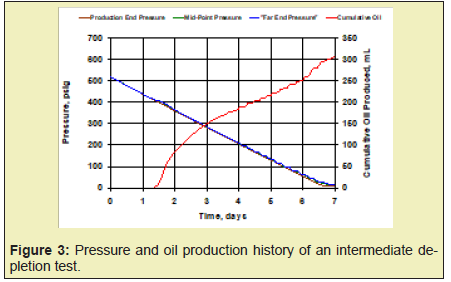
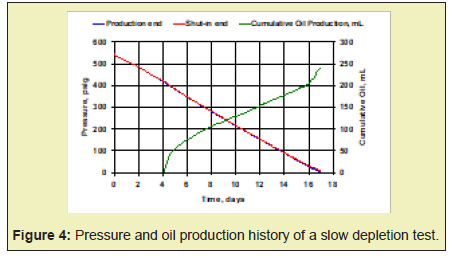
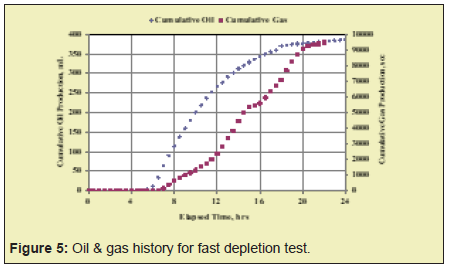

The average pressure changes very slowly in the field but the production wells in cold heavy oil production are often kept pumped off; meaning the drawdown pressure is kept high, where different depletion tests were described in Busahmin BS,1,2 Maini BB,3 Abusahmin BS,4 for the purpose of enhancing oil recovery. It was observed in many publications that the rate of pressure decline in the field is in orders of magnitude slower than in the laboratory experiments.1-3 It has been proposed that perhaps the high-rate laboratory is more important. The average pressure changes depletions are irrelevant for the field situation. However, if it is the drawdown pressure rather than rate of pressure change that is more important, the picture changes completely. The drawdown pressure is often higher in the field than in the laboratory experiments,4-8 so these high-rate tests are very relevant for the field situation.
Preparation of sand-pack
The water used in filling the pressure transducers was deionized water that was boiled to remove dissolved gases to minimize the formation of gas bubbles in the pressure transmitting lines and resulting artefacts in the pressure measurements.
Preparation of live oil
Live oil was prepared my mixing the desired gas with dead oil using a mixing cell. The mixer was then filled with dead oil, three quarters of its volume that is about six liters, and gas was introduced into the mixer at a pressure marginally higher than the desired bubble point pressure of the live oil. Once the pressure dropped below the desired bubble pressure more gas was added to the mixer to reach the desired pressure. Finally, the live oil was further agitated for another 24 hours to make sure the system was at equilibrium.
The primary depletion tests conducted with refined mineral oil saturated with methane, ethane, and carbon dioxide. The gas-oil systems characterized by measuring various parameters, for example, gas oil ratio and live oil viscosity as shown in Table 1.
The authors would like to really thank the university of Calgary for providing the desired equipments to conduct this research as well as the university techmology Brunei for providing the facility.
None.
Authors declare that there is no conflict of interest.
- 1. Busahmin BS, Maini BB. Comparison between Foamy mineral oil and crude Oil under Solution-gas drive, conference proceedings in oil and gas conference, Calgary, Alberta, Canada, 2011.
- 2. Busahmin BS, Maini BB, Sabet M, et al. Studies on the stability of the foamy oil in developing heavy oil reservoirs, conference proceedings in 12th international conference on diffusion in solids and liquids, Split, Croatia, 2016.
- 3. Maini BB, Busahmin B. Foamy oil flow and its role in heavy oil production. in Porous Media and Its Applications in Science, Engineering, and Industry: 3rd International Conference. AIP Publishing. 2010.
- 4. Abusahmin BS, Rao Karri R, Maini BB. Influence of fluid and operating parameters on the recovery factors and gas oil ratio in high viscous reservoirs under foamy solution gas drive. Fuel. 2017;197:497-517.
- 5. Bashir Busahmin, Brij B Maini. A potential Parameter for Foamy oil flow under Solution Gas Mechanism, Compressibility Related. International Journal of engineering & technology IJET. 2018;7(3.3):126-131.
- 6. Busahmin BS, Maini BB. Effect of solution-gas-oil-ratio on performance of solution gas drive in foamy heavy oil systems, Society of Petroleum Engineers - Canadian Unconventional Resources and International Petroleum Conference. 2010.
- 7. Busahmin B, Maini BB. Measurements of surface tension for mineral and crude oil systems. Defect and Diffusion Forum. 2019;391:106-113.
- 8. Busahmin B, Karri RR, Tyson S, et al. Modeling of a long sand-pack for heavy crude oil through depletion tests utilizing methane gas. 2021;7(2):188-119.

